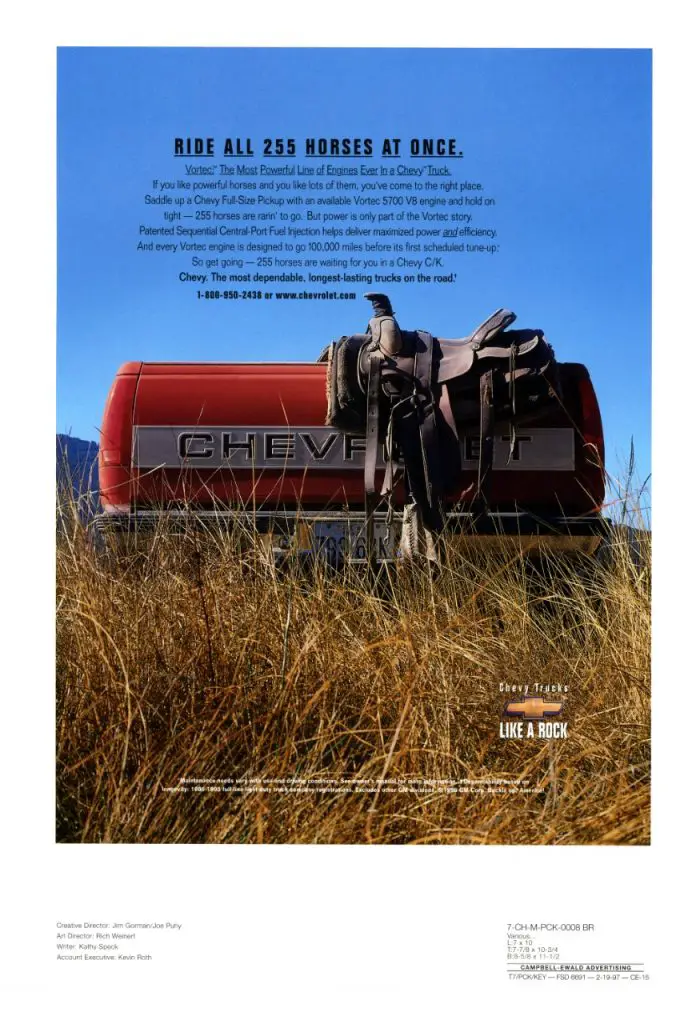Chevy’s small-block V8 has been a constant in American trucks for seven decades, powering generations of drivers from job sites to backcountry roads. Since its debut in 1955, this engine has been synonymous with reliability, performance, and a whole lot of grit. It’s the powerhouse behind millions of Chevy trucks, from classic C10s to today’s 2025 Silverado. Here’s a look at how the small-block V8 became a cornerstone of Chevy trucks.
1955: The Start of Chevy’s Small-Block V8 Legacy

Chevrolet first introduced the small-block V8 in the 1955 Task Force pickups, a series that brought a modern look and a serious upgrade in power. This new 265 cubic-inch engine produced 180 horsepower and 260 lb-ft of torque, packed into a compact, simple design that made maintenance a breeze. Task Force trucks weren’t just about getting the job done—they looked sharp, too. The Cameo Carrier, known as the “gentleman’s pickup,” was one of the first trucks to blend style with function, and with a small-block V8 under the hood, it could back up its looks with real performance.
1960s: Small-Block Power Grows

In the 1960s, Chevy doubled down on the small-block V8, introducing a 283 cubic-inch version that cranked up the power while keeping that simple, easy-to-maintain design. The 1960 C10, with its “Turbo-Fired” small-block, quickly became a favorite among truck owners who needed an engine that could tackle work during the week and handle adventure on the weekend. Chevy ads touted the “Turbo-Fired” V8’s quick response and power, making it clear that this was an engine meant for those who took their trucks seriously.
1972: A True Workhorse Emerges

By 1972, Chevy’s small-block had become the backbone of their trucks. The C20 came standard with a 350 cubic-inch V8 (5.7L), offering even more torque and durability. Known for its reliability, this engine was perfect for anyone needing a truck that could handle rough jobs without breaking a sweat. The small-block’s straightforward design meant it was easy to repair and keep on the road, which was a big reason these trucks became a staple on farms, construction sites, and garages across the country.
1980s: Silverado and the Small-Block Make Their Mark

In 1981, the Silverado trim joined the Chevy lineup as the premium option for the C/K trucks, and it didn’t take long for Silverado to become a household name. With the addition of the 5.7L small-block V8, also known as the 350, Silverado brought smooth power and torque for towing and hauling, along with a more comfortable ride. By 1988, the fuel-injected 350 small-block in the half-ton Silverado was cranking out 210 horsepower—making it one of the most powerful engines in its class. Chevy ads dubbed it “the leaner, meaner power machine,” a nod to its fuel efficiency and strength, helping Silverado become a favorite for drivers who wanted a capable yet refined truck.

1999: Vortec and the Silverado 1500 Redefine the Small-Block

In 1999, Chevy separated Silverado into its own model series and introduced the Gen 3 Vortec 5300—a 5.3L small-block V8 with modern fuel injection and improved air flow, delivering smoother, more efficient power. Chevy’s Vortec engines marked a big step forward in performance and reliability, with the Vortec 5300 earning a reputation as a rock-solid engine for hard-working trucks. Chevy’s late ‘90s ads leaned into the strength of this engine, inviting drivers to “ride all 255 horses at once” and making it clear that the Silverado was built for those who needed serious capability.
2000s: Active Fuel Management and the Next Generation of Small-Blocks
In the 2000s, Chevy continued refining the small-block with Gen 4 V8s like the 5.3L and 6.0L. These engines were known for their durability and integrated Active Fuel Management, a system that deactivates cylinders to save fuel when the engine isn’t under heavy load. It was a smart move for an era when drivers wanted both power and better fuel economy. The Silverado 1500 became one of the top choices in the truck market, with a small-block engine that delivered impressive performance without emptying the gas tank.
2020s: The 2025 Silverado and the Gen Six Small-Block V8
Today, Chevy’s small-block V8 is still going strong in the 2025 Silverado 1500, which features the Gen Six 6.2L V8. Producing 420 horsepower and 460 lb-ft of torque, it’s the largest and most powerful naturally aspirated V8 in its class. Chevy’s engineers have kept the small-block at the top of its game, offering more power, fuel efficiency, and refinement than ever. This latest small-block engine is a testament to Chevy’s commitment to drivers who still want the rumble and reliability of a naturally aspirated V8.
In 2023, GM put down $854 million to keep small-block V8 production rolling at facilities in Michigan, Ohio, and New York. As EVs continue to grow, Chevy knows there’s a dedicated group of drivers who aren’t ready to part ways with their V8s. This investment is a clear message: the small-block V8 still has a place in Chevy’s future, and it’ll keep powering trucks for as long as drivers demand it.
Seven decades after it first roared to life, Chevy’s small-block V8 remains a favorite for truck enthusiasts who value its balance of power, simplicity, and reliability. From the Task Force to the Silverado, this engine has been the heartbeat of countless Chevy trucks, and it’s not going anywhere anytime soon. What will the future hold for the small block? What displacements will Chevrolet use for the sixth generation? Stay tuned to GM-Trucks.com for the answer.

